
Toney and Jack (November 1748)
On the first of November, 1748, two freedom seekers fled from the east end of Long Island. Toney, a nineteen-year-old “Melatto Man Slave,” and Jack, an eighteen-year-old Indigenous man, left behind the homes of their enslavers, John Tuthill and John Petty, disappearing into the cold autumn winds. Their absence did not go unnoticed. Within weeks, […]

Timothy (September 1771)
Block Island lies in Rhode Island Sound, about nine miles south of mainland Rhode Island and fourteen miles east of Long Island. Just under ten square miles in size, Indigenous inhabitants knew the island as Manisses, and today their Niantic, Narragansett, Wampanoag, and Pequot descendants are known as the Manissean people. By 1774 the island […]

Buck (October 1773)
Buck was young, just twenty-three years old, and identified as an “Indian Man” from the town of Warwick, Rhode Island. Some ten miles south of Providence, Warwick was a community of fewer than 2,500 people. Of these, eighty-nine were of African and eighty-eight of Indigenous ancestry. Buck was most likely enslaved, like many of these […]
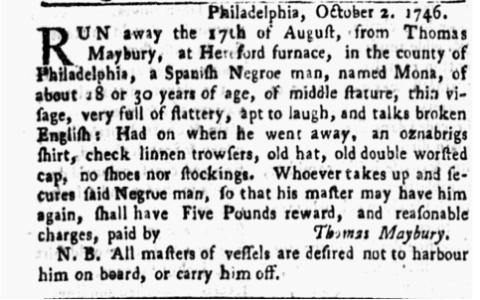
Mona (August 1746)
Mona ran away from Thomas Maybury’s property at Hereford Furnace in the County of Philadelphia on August 17, 1746. He is described as being “28 or 30 years of age, of middle stature, thin visage, very full of flattery, apt to laugh, and talks broken English.” His material circumstances, and the challenges he faced, were […]

Minny (March 1811)
In 1811, a young enslaved man by the name of Minny absconded from Milford, Prince William County, Virginia, presumably heading North to freedom. The earliest advertisement for his capture was submitted to the editor of the Alexandria Daily Gazette on March 6th, 1811, likely by Revolutionary War veteran Major Charles Ewell. Another set of advertisements […]

Adam (March 1775)
Sometime around the 15th of February 1775, an enslaved man named Adam fled from the northeastern coast of North Carolina. According to the advertisement placed in the North Carolina Gazette a month later, Adam was 5 foot 10 inches and 38 years old. Adam was older than many Freedom Seekers. Younger men were more likely […]

Harry (February 1804)
On April 1st, 1803, Harry made his way towards freedom and on December 12, 1803, Andrew Burnet, his enslaver, placed an advertisement in Charleston’s City Gazette seeking his return. Harry was Burnet‘s “waiting man,” an enslaved personal and domestic servant, and a position growing increasingly common in Virginian society. The consistent stream of advertisements offering […]

Hannah (February 1805)
Hannah appears to have escaped somewhere between a Mr. Leonard’s farm and the plantation in Alexandria, Virginia that belonged to her enslaver, Simon Sommers. She had eloped about two months before the publication of this advertisement in early 1805. Mr. Leonard had instructed Hannah to return to Sommers, perhaps because her time working for him […]

Fame (January 1806)
On January 15, 1806, an advertisement appeared in the National Intelligencer seeking the return of an enslaved woman named Fame. The advertisement stated that Fame, who was approximately 38 years old, had escaped from Thomas King of Prince George’s County, Maryland, in October of 1804, over two years earlier. What makes Fame’s case extraordinary is […]
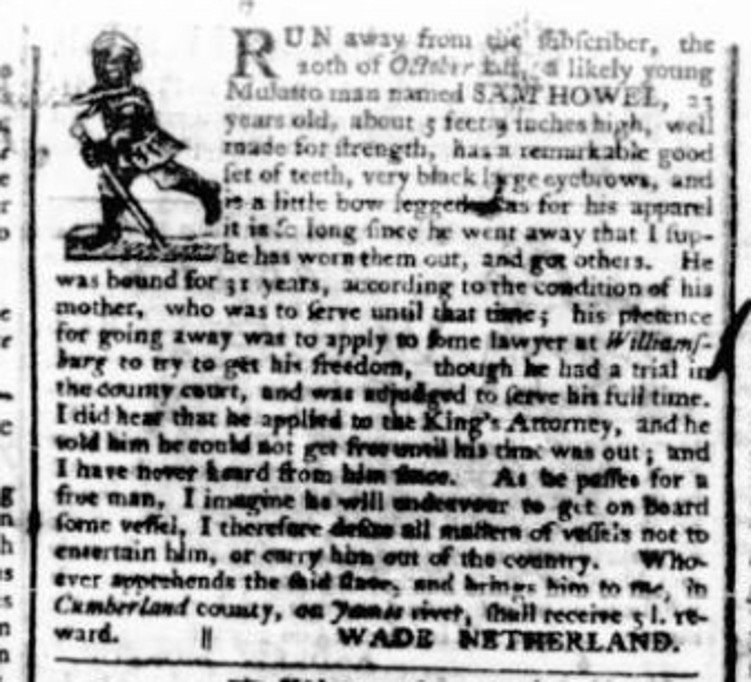
Samuel Howell (May 1766)
Samuel Howell, a mixed-race servant of Wade Netherland of Cumberland County, Virginia, ran away in October of 1765. In the advertisement for his return, published in Purdie & Dixon’s Virginia Gazette the following May, Netherland described Sam as “a likely young Mulatto man . . . 23 years old, about 5 feet 9 inches high, […]

Doctor Caesar/Augustus Thomson (December 1779)
It was a typical advertisement.[1] Caesar had escaped from the Roselle estate, which lay about five miles west of Morant Bay near Jamaica’s south-east coast. Andrew Murdoch, overseer at Roselle, described Caesar as an “artful” man and suggested that he might make his way to a town and attempt to pass as free. Caesar had […]

Pero (May 1782)
By the spring of 1782 the residents of Rhode Island knew that the war for independence was all but over. It had been three years since the British had abandoned Newport, more than six months since the British surrender at Yorktown, and peace negotiations were underway in Paris. It was at this moment that Pero […]

Crispas (October 1750)
Crispas was an imposing figure of a man, more than six inches taller than the average White American men of his time.[1] He came from Framingham, some twenty miles west of Boston, and a community of fewer than two hundred households and around one thousand residents. Crispas needed to get away if he was to […]

Billy, Tom, and Lubin (October 1785)
Could Billy, Tom, and Lubin have made it is far as Providence, some 1,500 miles north of Cap Français in Saint Domingue, working their way to the New England port on one of the many ships bringing goods from the Caribbean? Their enslaver clearly thought such an escape was possible, for P.F. Claessens and his […]

Bet (October 1776)
On October 3, 1776, a “young Negro woman named BET” emancipated herself in Philadelphia from the household of Thomas Stone, a lawyer and planter from Port Tobacco, Maryland, on the Potomac River, a delegate to the Second Continental Congress, and a signer of the Declaration of Independence. Because the woman known as Bet made her […]
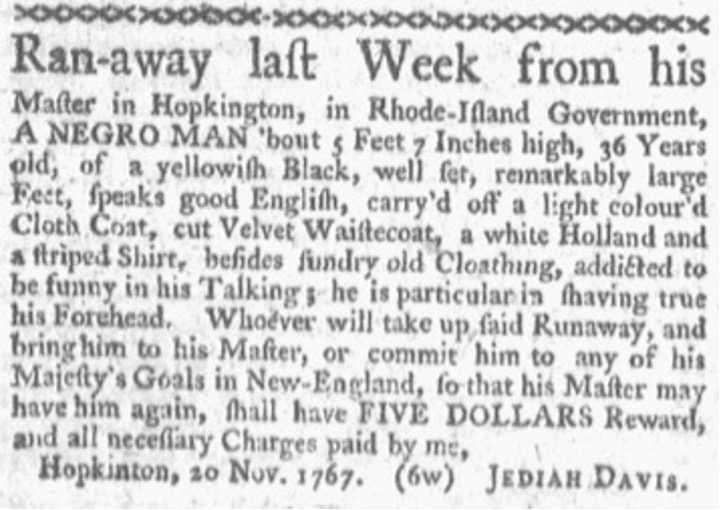
Name Unrecorded (November 1767)
Any relief New Englanders might have felt at Parliament’s repeal of the Stamp Act had swiftly disappeared in the face of the Declaratory Act (1766) and the Townsend Acts, which went into effect on November 20, 1767. Going far beyond the original Stamp Act, these new laws sought not only to raise taxation in the […]

Prime (June 1775)
Prime was only about fourteen years old when he escaped, a physically small boy who may not have been in Rhode Island for long. He had come to the colony from Suriname, a Dutch colony in which enslaved people grew and processed coffee, sugar, cotton, and cocoa. Almost 97,000 enslaved Africans were brought to this […]

Yockwhy (October 1777)
He was an African, his heritage visible for all to see in his dark colored skin and the ritual scarification on both sides of his face, a West African practice that was not replicated in the Americas. We do not know when he was trafficked to the Americas, or how he came to be in […]

Cuff (August 1768)
Cuff was eighteen when he escaped from one of the wealthier men in North Kingston, a small town across Narragansett Bay from Newport. It was early July 1768, and in the warm summer weather Cuff left with only the clothes he was wearing. Immanuel Case advertised for Cuff in the local Newport Mercury on July […]

York (August 1774)
It is not surprising that York and other freedom seekers hoped to join the crews of New England’s whaling ships. Often desperate for new hands, whaling ship captains proved more than willing to sign up Black men with little or no maritime experience, even if the captains suspected the men of having escaped enslavement. In […]

Tom (June 1781)
Tom was already about fifty years old when he made his bid for freedom. The War for Independence was drawing towards a close, as British forces withdrew from the Carolinas into Virginia, and were defeated at Yorktown a few months later. Slavery had been weakened throughout the new United States, particularly in New England, and […]

Name unrecorded (September 1742)
In September 1742 Johannes Van Houte of Bergen, New Jersey advertised for a “Malagasco yellow Negro wench” who was about 47 years old, marked by a “scar on her right cheek,” and fluent in Dutch.[1] Though the advertisement offers few details about her escape, it hints at important aspects of the unnamed Malagasy woman’s life, […]
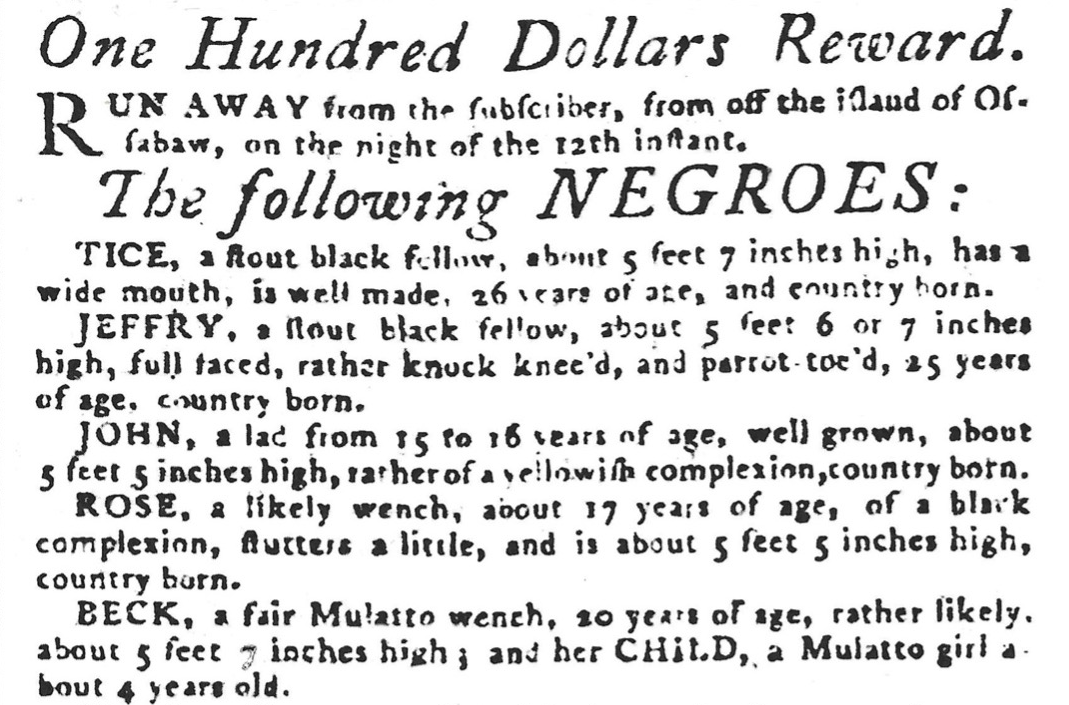
Titus (January 1795)
On the night of January 12, 1795, seven individuals escaped from a Sea Island cotton plantation on Ossabaw Island in a small two-oared canoe with pots, blankets, clothing, and, as it turned out, a shotgun and a rifle, and made it to Amelia Island, the northernmost point of Spanish East Florida. They expected to find […]

Alice (August 1796)
Alice was an enslaved woman who in 1796 escaped from Delaware to what was then the nation’s capital, Philadelphia. Jesse Higgins, the main who claimed ownership of Alice, was particularly upset by Alice’s escape, although the nature of his unhappiness differed from that of other enslavers who were angered by the escape of people they […]

Name unrecorded (December 1810)
Around Christmas of 1810, a young boy, an adolescent of 14 or 15 years of age, whose name we will never know, is “picked up” in Fort Royal, Martinique, on the road leading to Fort Bourbon. He is found “in a dying condition.” The boy neither protested about being free, nor was he able to […]

Monday (February 1777)
In just two hundred words a newspaper advertisement tells us virtually all that we know of the escape of an enslaved boy in Jamaica in February 1777. His name was Monday and he had escaped from Isaac Penha on January 30th, 1777. Penha came from Santa Cruz, a small town in St. Elizabeth, Jamaica, located […]

Edward Tamar (April 1767)
In 1767 Edward Tamar was one of a significant number of enslaved people owned by William Trebell, and Tamar was working for Trebell in the Raleigh Tavern in Williamsburg.[1] But he was also an enslaved man who had enjoyed a long period of freedom and who had created a life for himself as a free […]

Charles Thompson (September 1784)
The oppressive humidity and heat filled the house. The symphony of crickets and a continuous hum of mosquitoes perhaps woke many from their sleep. Within this dimly lit room, the only light source was the moon filtering through the lone glassless opening. Illumination from the moonlight revealed the faces of some of the ten enslaved […]

Jordan (June 1810)
Jordan – we see you! He was a child of 14. And if he had “a lie ready to answer every question,” we can know he was nimble and clever. We can be sure that the child had lived a hard life without any investigation, for the clues provided in this advertisement leave little room […]

Caesar (November 1774)
On or about October 1, 1774, an enslaved Virginian named Caesar slipped away from the site of his bondage, ascended and crossed the Appalachian Mountains, likely descended the Kanawha River to the Ohio, and made his way to the Shawnee villages on the lower Scioto River in the Ohio country, where he sought sanctuary.[1] Caesar […]
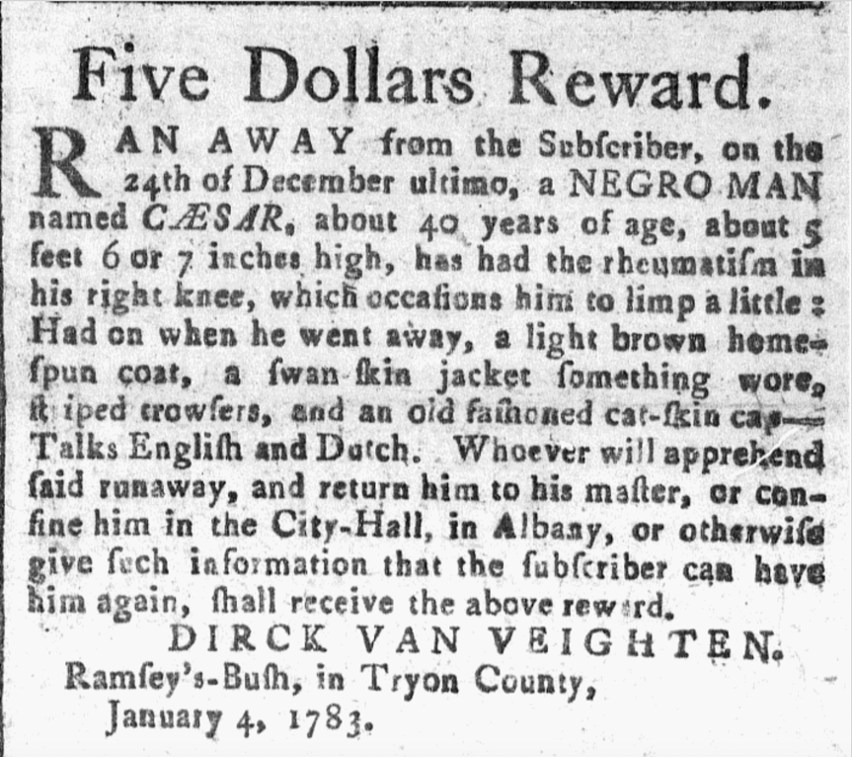
Caesar (December 1782)
On Christmas Eve, 1782, a forty-year-old enslaved man named Caesar ran away from his owner’s farm in the upper Hudson River Valley of New York State. He was “about 5 feet 6 or 7”—about average height for the time period—and had a slight limp due to “rheumatism in his right knee.” He wore a home-spun […]

Cécile (February 1795)
Cécile was born in colonial Saint-Domingue in the early 1770s, on the cusp of what would later become known as the ‘age of revolutions.’[1] She lived a life that was shaped by those political, military, and social upheavals. In 1793, two years after the beginning of the Haitian Revolution and at the very moment that […]

Daniel Anderson (August 1783)
He called himself Daniel Anderson when he sought refuge from slavery in 1777. He seems to have been calling himself Daniel Anderson for a while, although many of his enslavers called him London. It is unclear what he called himself when he was growing up in the 1750s along Marshyhope Creek, a tributary of the […]

Scipio Gorrey (October 1782)
Slave names tell stories, complex and nuanced ones. They document ties of sentiment between mothers and daughters. They represent lineages fathers bestow on their sons. Names also embody the hopes, dreams, and aspirations of parents, enslaved as well as free, who wanted a better life for their children. For some enslaved African Americans like Goree, […]

Abel (December 1773)
Abel was born about 1730. Identified as a “Mulatto,” he was almost certainly the son of a white man and an African-born or African-descended woman. If he was born in Virginia, his mother could have been one of the many girls and women enslaved and transported to the Americas in the early eighteenth century. Perhaps […]
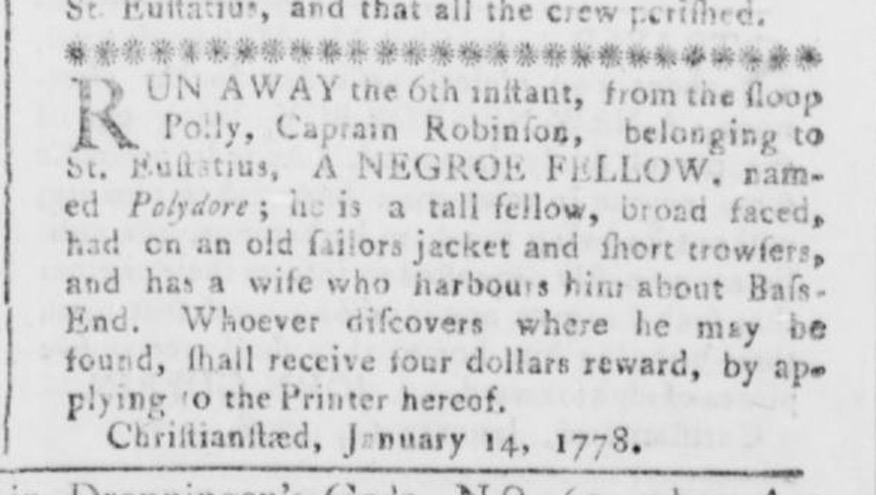
Polydore (January 1778)
On 16 November 1776, Isaiah Robinson, captain of the Andrew Doria, sailed into Oranjestad, the capital of St. Eustatius, a Dutch Caribbean colony. Seeking to purchase weapons and gunpowder for the United States and flying the flag of the Continental Congress, Robinson fired a thirteen-gun salute, one for each of the newly independent states. St. […]

Jack and Venus (November 1771)
On November 18, 1771, two of Nathaniel Burwell’s enslaved people absconded from his place in Warrasqueak Bay. Unlike most planters of his day, he elected to wait before turning to print. Rather than solicit the attention of his neighbors by way of a newspaper advertisement, the Virginia grandee might have thought a more sensible course […]

Stepney (August 1751)
Stepney had seen a lot of the world. He may well have been born more than five thousand miles east of Virginia, for more than one-third of mid-eighteenth Virginia’s enslaved population had been born in Africa.[1] If that were the case, his oceanic travels had begun with the horrific Middle Passage, but thereafter his journeys […]

Bacchus and Sukey Jones (October 1773)
How quickly resistance could become revolution. In Boston in the Fall of 1773 popular anger at Parliament’s passage of the Tea Act was building, and in mid-December the arrival of the first tea shipments prompted the Boston Tea Party. When Parliament responded with the Coercive Acts of 1774, delegates from twelve colonies would meet in […]

Pero, Jack, & Isaac (November 1765)
What connected people in early America? For some, it was blood ties. This was certainly true of Colonel Job Almy, an enslaver who belonged to one of Rhode Island’s oldest families. Arriving from England in 1630, the Almy family subsequently spread throughout the Narragansett Bay, with its patriarchs establishing themselves as yeomen, merchants, and local […]

Bridger (June 1799)
Two days after the above advertisement appeared in the Antigua Journal a second appeared in the Antigua Gazette, also published in St. John’s. The text of the two notices is virtually identical but the accompanying woodcut images are strikingly unusual. In each advertisement the crudely fashioned image of a freedom seeker on the run is […]
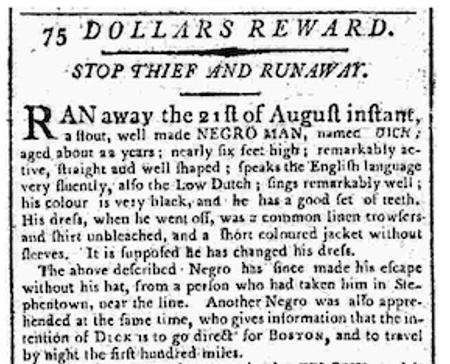
Dick (August 1796)
It was an exceptionally hot summer day when Dick fled Albany, New York, in August of 1796.[1] He was hoping to make it to Boston, the capital of neighboring Massachusetts. His escape appears to have been a planned and perhaps coordinated effort. He fled on a Sunday, when his enslaver Killian K. Van Rensselaer attended […]

Bacchus (June 1774)
What did the landscape of freedom look like to enslaved people seeking to escape bondage on the eve of the American Revolution? Where in the Atlantic world did runaways think they could find freedom? In the eyes of Bacchus, “a cunning, artful, sensible Fellow” about thirty years old who ran away from his owner in […]

Isabel, Dorus, and Tom (July 1799)
There are tens of thousands of enslaved runaway advertisements in the classified columns of New World newspapers. They are shards, relics from two centuries and more ago. Compressed, factual, and fleeting, these advertisements reveal something of not just enslaved life but perhaps, as was quite possibly the case with Isabel and family, the vital and […]

Charles Harding (July 1772)
Who was Charles Harding? What kind of man was he, and what kind of life did he have? There is so much that we shall never know, for although he was the subject of at least two advertisements, each around four hundred words in length, Harding is obscured as much as he is revealed by […]
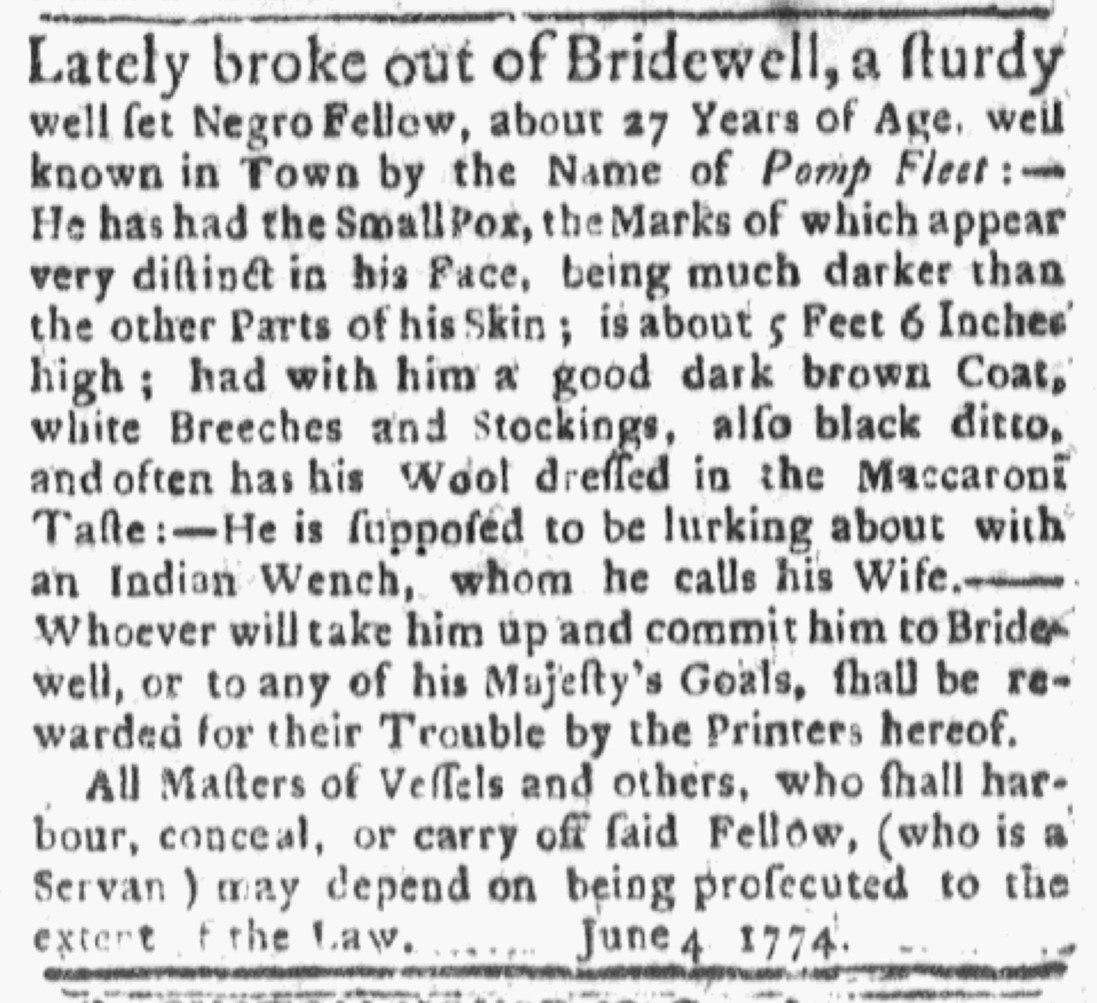
Pompey Fleet (June 1774)
When Pompey Fleet was born in the year 1745, his mother, Venus, could scarcely have imagined the course that her child would chart in life.[1] Pompey would grow up to escape slavery, and then, thanks to his British allegiance in the American Revolution, to escape North America altogether. Ultimately, Pompey would return to the continent […]

Clem (June 1771)
During the Age of the American Revolution, an enslaved man named Clem left his enslaver, a Catholic priest and a papist patriot, and protested slavery with his feet. Like other bound people in the Chesapeake, he left in the summer, as the weather improved. Determined to own himself, if merely for a brief period of […]

Silva (June 1784)
Silva’s story appeared in the Connecticut Courant on June 22, 1784. The Courant reprinted her story a week later, on the 29th, and once again on July 6th. Her story is one filled with violence, tragedy, and silence. For her story is also an account that reveals in explicit and implicit ways, the unusual complexities […]

Five (May 1783)
Peculiar indeed is the politics of naming. In a time in which men and women owned other men and women as property, as a simple-minded beast of burden, naming signified power. In the minds of those who were subject to its prerogative, naming represented the ultimate expression of a master’s control over his or her […]

Goree (May 1774)
This advertisement appeared in the Boston Post-Boy. The Boston Evening Post and the Essex Gazette also published a copy of the bulletin.[1] Reflecting perhaps the intensity of the moment, reprints appeared in subsequent editions of both newspapers. The story they reveal is a complex one. Whether in the pages of the Boston Post Boy or […]

Billah (June 1743)
Billah’s story is one that includes several recurring themes in advertisements for freedom seekers. Concealed between the lines of the bulletin her enslaver had posted for the enslaved woman’s apprehension lies the interlocking subjects of memory, resistance, agency, and cultural resiliency. Like most stories about African Americans before emancipation, Billah’s is not simply a matter […]

Letitia (April 1739)
The days were shortening in 1733, and the chill of winter tightening its grip on Boston, when Letitia found a visitor on the stoop. Letitia at the time might have been seven, the age at which children began to be considered useful in New England, or perhaps she was a bit older—ten or so.[1] A […]

Penelope (June 1704)
Did Penelope’s heart pound as she took shelter in the forest on the outskirts of town? Did she gasp for air as she tore through the nearby farmland? Or did her feet make nary a patter on the town dock as she crept under cover of darkness to a waiting vessel? No one knows how […]

George Samba (August 1776)
Barely a month after crowds outside the Pennsylvania State House cheered the first public reading of the Declaration of Independence “a Black Lad” named George Samba made his own bid for independence. In Wapping, On August 12 this fourteen-year-old African escaped from his master’s home on Bird Street, today known as Tench Street, lying a […]

Free Poll (May 1781)
As the name she gave herself after fleeing her enslavers signifies, Free Poll took advantage of the possibilities offered during the American Revolution to declare her own freedom, live with her husband, find paying work, and fashion a life in a growing community of Black Philadelphians, both enslaved and free. Like many freedom-seeking women at […]

Daniel, Dick, Dorcas, Jack, James, and Mary (November 1764)
Enslaved Black people and White indentured servants sometimes co-operated in efforts to free themselves. In the Fall of 1764, Jack, Dick, Daniel, and Dorcas organized a well-planned escape with two white bound servants, James and his Irish wife Mary. They took a good many items valuable for their escape, including sheets and blankets with which […]

Cuff Dix (July 1776)
Cuff Dix was determined to be free. Again and again he escaped, even when his enslaver restrained him with collars and chains.[1] But his efforts at self-liberation in the spring of 1775 and again in 1776 were different from an earlier attempt in 1774. Mark Bird, the man who enslaved Cuff Dix, was worried that […]
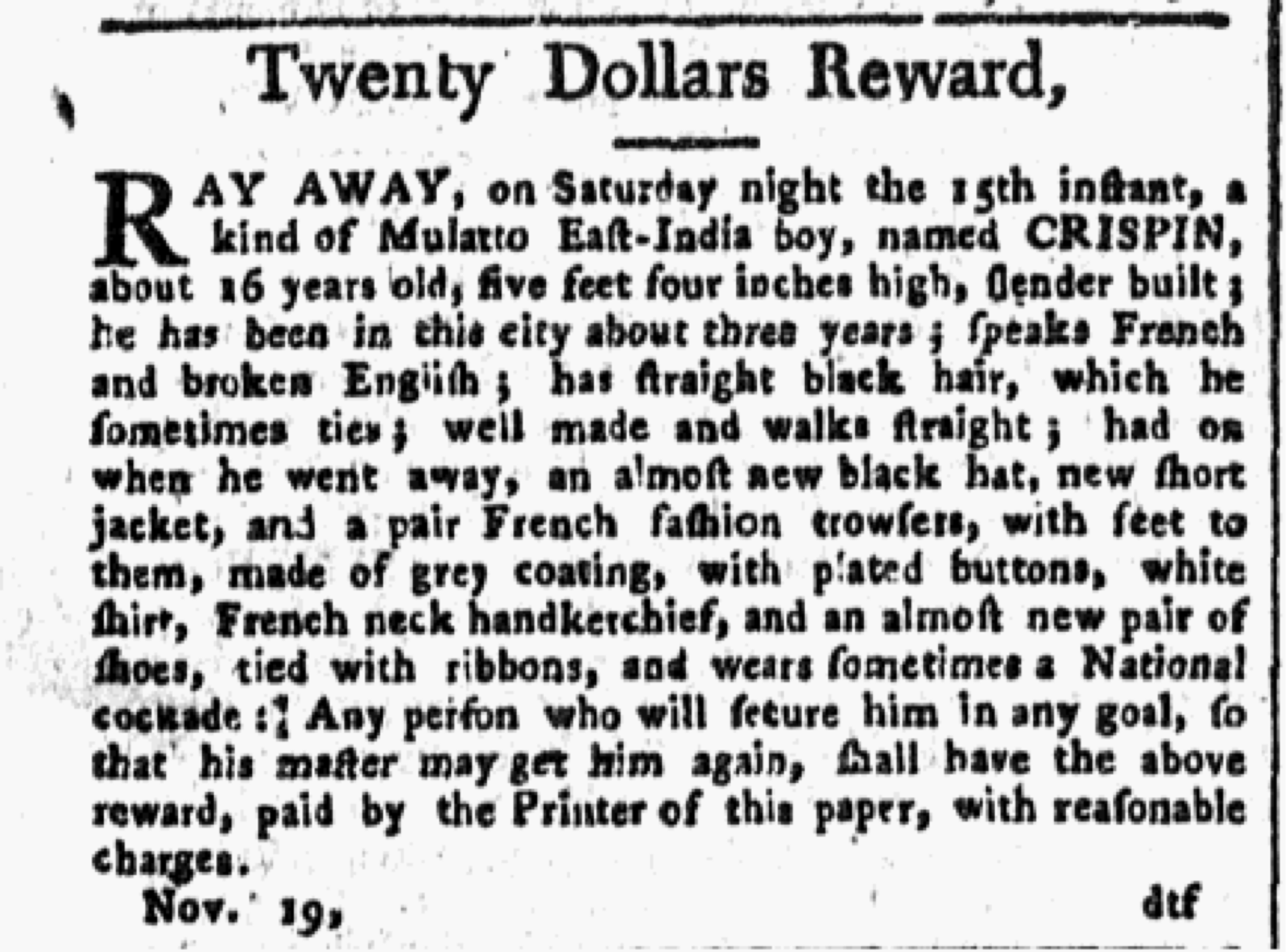
Crispin (November 1794)
Crispin fled enslavement and successfully established his freedom. Moreover, while still enslaved, he boldly indicated his politics by the clothing he wore, clearly sympathizing with the Black revolutionaries on St. Domingue (later Haiti) who fought and died to abolish racial bondage on the island. After making his way from Philadelphia to St. Domingue, Crispin enjoyed […]

James Teernon (November 1761)
It is quite possible that James Teernon had been born in Africa. The scar on his forehead might have been a ‘country mark’, the ritual scarification practiced by some West African peoples. Furthermore, he was described by Captain Terrence Teernon as a man who “speaks good English,” a form of phrasing commonly used for those […]

Caesar (October 1759)
Even more than most freedom seekers, Caesar showed incredible determination to liberate himself. Although he was missing both of his legs, he nevertheless escaped his enslaver, Sarah Massey, and made a break for freedom. Life in places like Chestertown, Maryland, where Caesar was foribly held in bondage, was oriented to the nearby Chesapeake Bay. Although […]

Achilles (October 1776)
By July 4th 1776 Achilles had already freed himself. He had eloped in April, not long after arriving in Jamaica from West Africa. Francis Partyn, presumably the man running the Belvidere Plantation, believed that the freedom-seeker has come from “the Congo country,” the West Central African point of departure for just under half of all […]

Jack (August 1730)
How might we today visualize the appearance of people who fled enslavement? How can we give faces to the supposedly faceless in history? The 18th-century clothing described in this advertisement can be reconstructed with some accuracy, as will be discussed below. It is more difficult to imagine their bodies, including their physical features, posture, hair […]